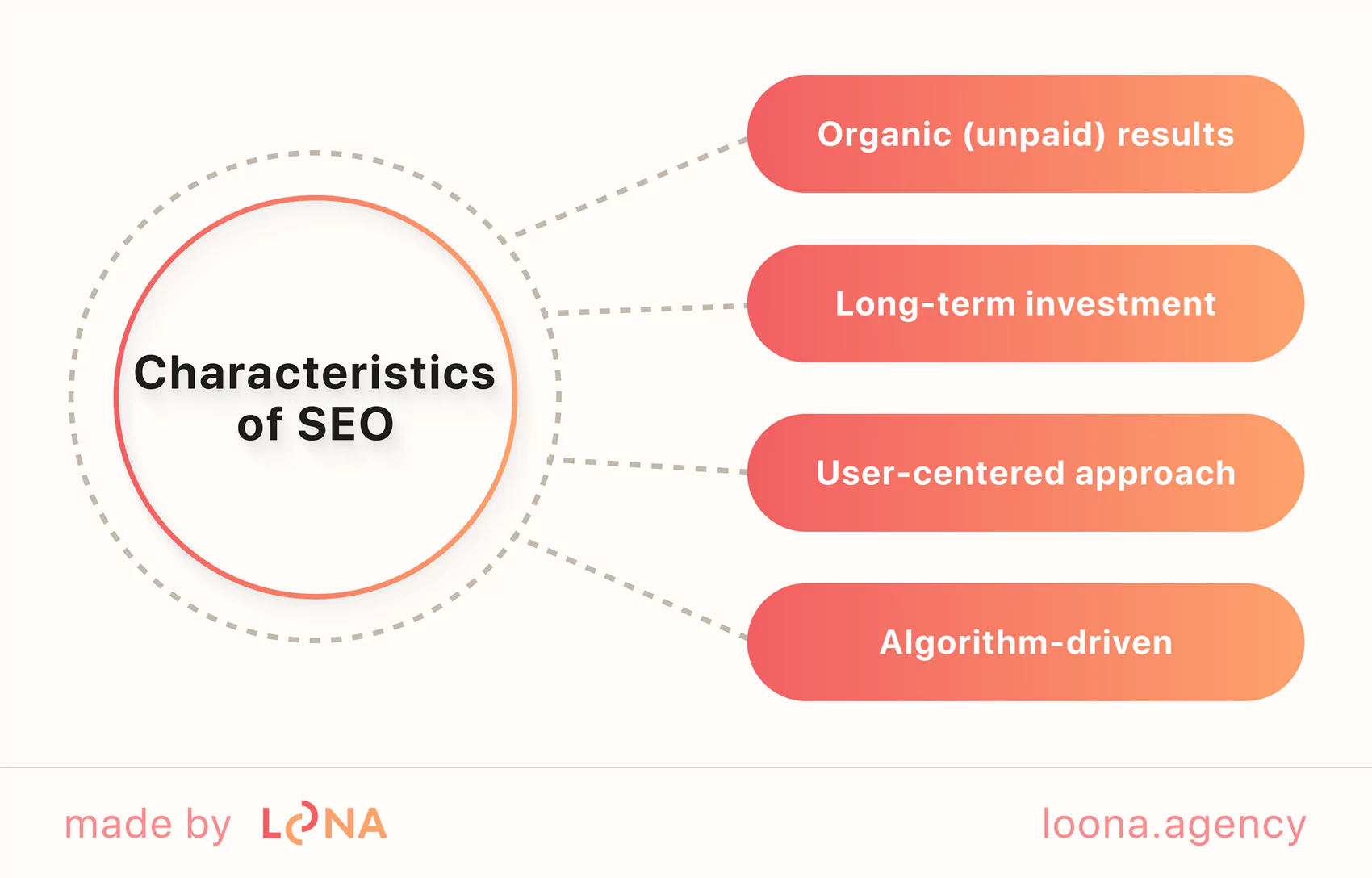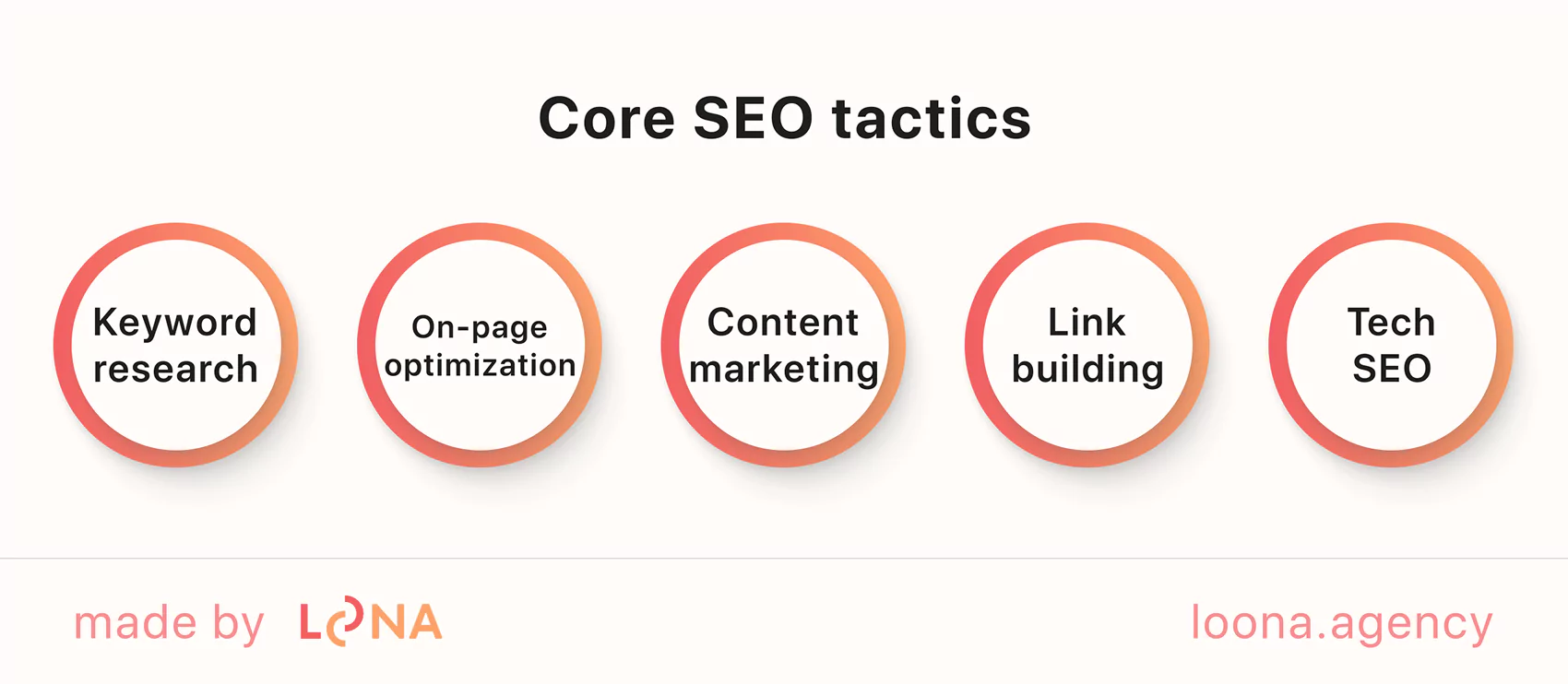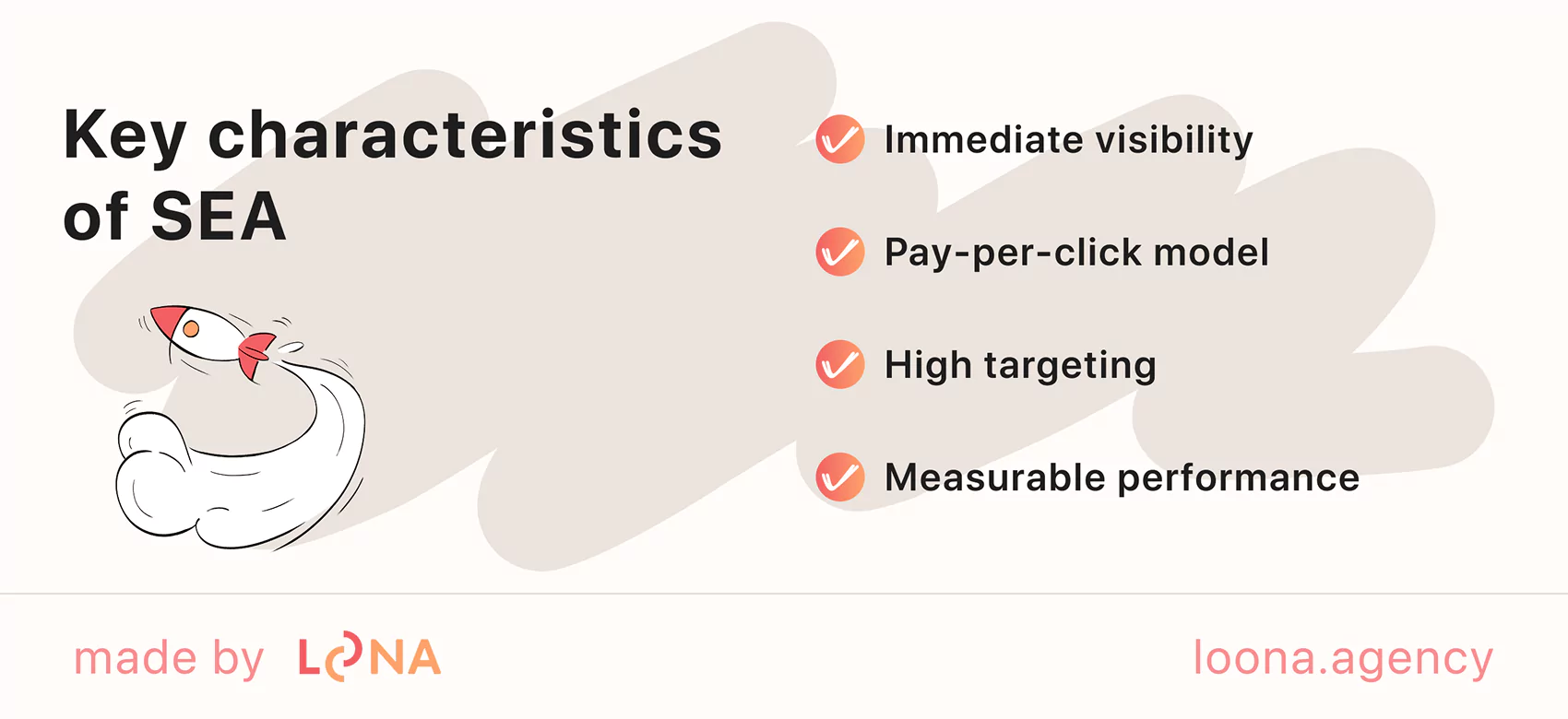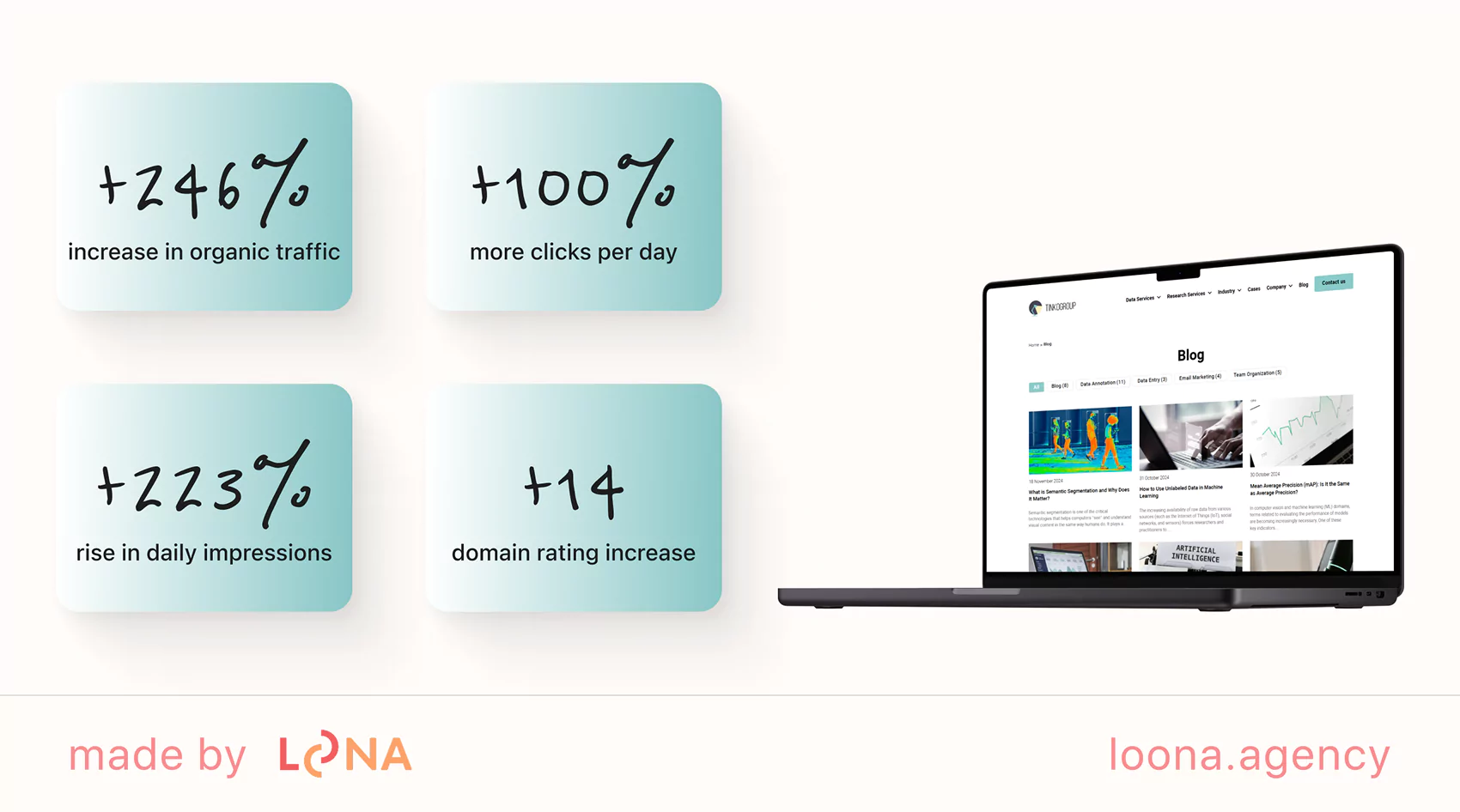SEO vs. SEA: Understanding the Key Differences for Online Success

Want to get noticed on search engines? There are two marketing approaches that will help you reach this goal - SEA and SEO, but they work differently. SEO focuses on organic growth—optimizing your content to rank naturally over time. SEA utilizes paid ads to deliver immediate visibility at the top of search results.
Knowing when and how to use each strategy plays an integral role in generating traffic. Read this article and discover when to choose SEO vs SEA and when you can apply them both to achieve your business aims.
What is SEO (search engine optimization)?
If you’ve ever looked for something you need on Google and then clicked one of the top results, chances are that page got there thanks to good SEO.
To understand SEO & SEA more clearly, let's start with SEO. We will break it down into three key parts: its definition, characteristics, and the main tactics used to implement it effectively.
Understanding SEO: A clear definition
Search engine optimization, or SEO, is the dedicated process of optimizing a site to perform better in free (organic) search engine rankings. When consumers search for topics for which your business provides solutions, a well-optimized website will receive more traffic—bringing in more traffic without the cost of advertising.
In short, SEO makes it possible for search engines to interpret your content and allows others to locate your site when they are looking for something you offer.
Key characteristics of SEO
SEO has several key characteristics that make it different from paid search strategies. Understanding these characteristics will allow you to see how SEO can be a part of your long-term digital marketing strategy.

Organic (unpaid) results
SEO focuses on search positions in the natural listings rather than paying for ad positions. You don't pay per click, so it's a low-cost way to build traffic, but this marketing approach works in the long run. You should be prepared that the best results of an SEO campaign are usually seen in the second or third year.
Long-term investment
As a counterpoint to pay-per-click ads that don't bring traffic once your money runs out, SEO builds value gradually. It might take a bit longer to get the payoff, but the effect is more long-term and steady.
User-centered approach
Good SEO is not merely search engine-based—it's about providing value to users. Fast page loads, mobile usability, easy navigation, and content quality all contribute to better rankings and an enjoyable user experience.
Algorithm-driven
SEO relies heavily on search engine algorithms. These algorithms analyze dozens of variables—relevance, authority, and page speed—to determine where your content ranks.
Key SEO tactics
To succeed with SEO, you’ll need to apply a combination of techniques that improve both the technical and content aspects of your site. Here are the most important tactics:

Keyword research
This is the foundation of SEO. It involves finding out what terms your target audience is searching for and using those keywords strategically in your content. Tools like Google Keyword Planner or SEMrush may help discover high-value keywords.
On-page optimization
This is making the items on each page rank higher. Some of the key spots are:
Title tags and meta descriptions
Header tags (H1, H2, etc.)
URL structure
Image alt text
Internal linking
Content marketing
Creating high-quality content that informs individuals not only allows you to rank for additional keywords but also ensures your site becomes an authoritative resource. Guides, blog posts, infographics, and videos can all be beneficial for SEO when aimed and optimized correctly.
Link building
Backlinks—links from external sites to yours—are an essential ranking signal. Search engines view them as a trust vote. Getting good-quality backlinks through guest blogging, digital PR, or partnerships makes your site more authoritative.
Technical SEO
This SEO tactic ensures search engines are able to access, crawl, and index your website correctly. It includes:
Mobile-friendliness
Fast page speed
Secure connections (HTTPS)
Clean site architecture and XML sitemaps
Fixing broken links and errors
What is SEA (search engine advertising)?
With today's competitive online market, having a website is not enough—you need to put it in the eyes of the right people at the right moment. This is where SEA comes in. SEA is a paid method that puts your company on top of search engine results pages (SERPs), driving targeted and instant traffic to your website.
Let's take a closer look at how it works and why it's such an integral part of so many digital marketing plans.
Understanding SEA: A clear definition
Search engine advertising is a paid online marketing strategy through which businesses can place ads directly on SERPs. Unlike SEO, which focuses on earning visibility organically, SEA enables advertisers to bid for ad placement in prominent positions—typically above or beside organic search results.
These ads are triggered by specific keywords that users search for, making SEA a powerful tool for reaching potential customers who are actively looking for your products or services. You only pay when someone clicks on your ad, which is why this model is often referred to as pay-per-click (PPC) advertising.
Key characteristics of SEA
Comparing SEO versus SEA, search engine advertising stands out for its speed, targeting precision, and flexibility. Here are some of its defining features:

Immediate visibility
SEA allows you to appear at the top of search results almost instantly, which is especially useful for new websites or time-sensitive campaigns.
Pay-per-click model
You should pay just when someone actually clicks on your ad. It is a great way to drive targeted traffic, provided your campaigns are well-optimized.
High targeting
SEA platforms let you target users based on keywords, location, device (mobile or desktop), language, time of day, and more. This means your digital ads reach the right target group at the right time.
Measurable performance
SEA offers detailed analytics on clicks, impressions, conversions, and ROAS (return on ad spend), allowing for continuous optimization.
SEA platforms and common ad formats
Several major platforms offer SEA solutions, each with various ad types tailored to different goals and industries:
Popular SEA platforms
There are several prominent platforms, each possessing their own unique features.
Google Ads: The most widely used SEA platform, reaching billions of users across Google Search, YouTube, and partner sites.
Microsoft Advertising (formerly Bing Ads): Reaches audiences on Bing, Yahoo, and AOL, often with lower competition and cost-per-click.
Common ad formats
SEA offers different ad types for multiple business goals and user behaviors, from simple text ads to visually appealing product pages.
Text ads: Simple ads that appear at the bottom or top of search results with a headline, description, and link.
Shopping ads (product listing ads): Visual advertisements for e-commerce that display product images, prices, and store names—ideal for online retailers.
Responsive search ads: Ads that automatically test combinations of headlines and descriptions to improve performance.
Call ads and location ads: Designed to drive phone calls or foot traffic, especially useful for local businesses.
SEA is a powerful strategy to generate traffic to your site. Below in the article, we will also talk about SEO SEA online marketing, and how you can combine these two approaches.
Main differences between SEO and SEA
Though both SEA and SEO are aimed at elevating your website's visibility on search engine pages, they function in strongly different ways. Knowing the core differences between the two approaches can allow you to make smarter decisions about where to allocate your digital marketing budgets (or how to best utilize both in combination).
Here is a summary of how these SEO & SEA stack up in major areas:
Category | Search Engine Optimization | Search Engine Advertising |
Cost | No direct cost for clicks; relies on time and effort | You pay for each click or impression (PPC model) |
Speed of results | Slower to take effect; long-term growth strategy | Delivers immediate visibility once ads are active |
Search placement | Appears in unpaid (organic) search listings | Shows up in the paid ad sections at the top or bottom of ad results |
| Impact duration | Results can last long after work is done | Visibility ends when you stop funding your campaigns |
Click behavior | Organic results often win more trust and clicks over time | Ads can attract quick attention but may be skipped by some users |
Level of control | Less control over how and when rankings change | Greater control over budget, timing, targeting, and ad content |
Perceived trust | Generally viewed as more credible by users | Clearly marked as ads, which can affect user perception |
Audience targeting | Depends on keyword relevance and quality of content | Advanced options for precise targeting (e.g., location, device) |
Performance tracking | Needs third-party tools (e.g., Google Analytics, Search Console) | Built-in metrics and real-time insights from ad platforms |
When to use SEO
So, the main question is what to choose: SEO or SEA? Let’s consider when to apply SEO better.
SEO is the preferred option if you are looking to create stable, long-term visibility in the search engines. It is a strategic solution for those businesses that can invest time in building quality content, gaining backlinks, and building a website structure.
Search engine optimization is well-suited when:
You must have ongoing, free traffic over a time span without paying per visit.
You need to build brand trust and a lasting internet presence.
Your site has informative or helpful content (like guides or blogs) that is open to optimization.
You don't have results immediately and are willing to wait a few months for organic results.
SEO is basically an online asset that is long-term in nature. Once your pages are ranking, you can yield consistent traffic with minimal recurring SEO cost.
When to use SEA
Search engine advertising is best suited for situations where speed, precision, and immediate visibility are crucial. It’s especially powerful for promoting time-sensitive offers or quickly gaining attention in a competitive space.
Comparing SEO versus SEA, the latter is ideal to use when:
You need instant visibility in the top search positions.
You’re launching a new campaign or product and want fast traffic.
You’re running promotions, sales, or seasonal deals that have a short window.
You need to target very precise audiences, for example, by device, location, language, or demographics.
You require precise performance metrics and immediate feedback in order to adjust your strategy.
SEA allows full control of your budget and targeting, and thus it is an adaptive and result-driven advertisement channel.
Can SEO and SEA work together? The power of synergy
Rather than having to choose one or the other, for example, a SEA vs SEO, a combination of these approaches can yield a more powerful, more comprehensive strategy. Combined, these strategies reinforce each other's strengths and compensate for each other's weaknesses.
Why use SEO SEA marketing?
Improved visibility: You get to appear in paid results as well as organic results, becoming more prominent on the search results page.
Smarter keyword targeting: Use data-driven insights from your SEA campaigns to determine what keywords best perform, then focus on SEO efforts there.
Faster content traction: Promote new SEO-focused content to drive early traffic and backlinks.
A/B testing benefit: A/B test messaging or offers within ads before launching full content campaigns there.
While SEO builds your long-term foundation and SEA yields quick success, your marketing strategy is fortified, made more agile, and more profitable.
How Loona Agency turned SEO into a lead machine for a client
In today’s digital-first economy, having great services isn’t enough—if your ideal clients can’t find you online, your growth will stall. That’s exactly where Tinkogroup, a data annotation and lead generation company based in Estonia, found themselves.
Despite strong performance on freelance platforms like Upwork, they realized they needed to diversify and strengthen their direct digital presence to keep scaling.
Tinkogroup partnered with us to execute a comprehensive SEO and digital marketing strategy focused on improving search rankings, boosting organic traffic, and converting more site visitors into qualified leads.
Before our collaboration, Tinkogroup already had a solid client base but struggled to compete in organic search against larger players in the data services space. They believed that organic traffic would deliver higher-quality, longer-term leads—but needed expert help to get there.
Our winning strategy
To address these challenges, we developed and executed a full-funnel digital marketing plan focused on five core areas:
SEO optimization: Keyword strategy, meta tag updates, technical fixes
Content marketing: Creation of informative blog posts and landing pages targeting customer intent keywords
Link building: Targeted outreach to earn high-authority backlinks and improve domain rating
Social media management (LinkedIn): Consistent, engaging posts for SMM to build credibility and reach
Email automation: Lead nurturing campaigns to stay top-of-mind with potential clients
We also upgraded the website’s UI/UX for a smoother user journey and implemented custom analytics dashboards to monitor SEO KPIs and performance in real time.
Results of our marketing efforts
The implementation of our digital marketing strategies led to improved conversion rates and lead quality:

These outcomes demonstrated the power of SEO not just as a traffic driver, but as a lead generation engine. Tinkogroup successfully reduced reliance on third-party platforms and took control of their digital growth.
You can turn to us if you also need a complex digital marketing strategy, SEO SEA online marketing, or any other service. We will help you to identify what will work best in your case.
Conclusion
The SEO approach and SEA are both important for establishing a solid online presence—but these strategies are used for various purposes.
Comparing SEO versus SEA, SEO is a natural visibility strategy that requires effort and time to bear fruit but will deliver long-term traffic and trust through quality content and authority. It's perfect for organizations looking to build up over the longer term and reduce dependence on paid media.
SEA, on the other hand, is ideal for immediate visibility and targeting particular groups all at once. It's suitable for product launches, short-term offers, or new fields with intense competition wherein SEO would be too slow to gain traction.
Whether you desire to increase organic traffic, launch an ad campaign, or combine both SEO SEA marketing strategies, Loona Agency is always ready to support you. Contact us today and let's create a growth plan that's tailored to your business goals.




